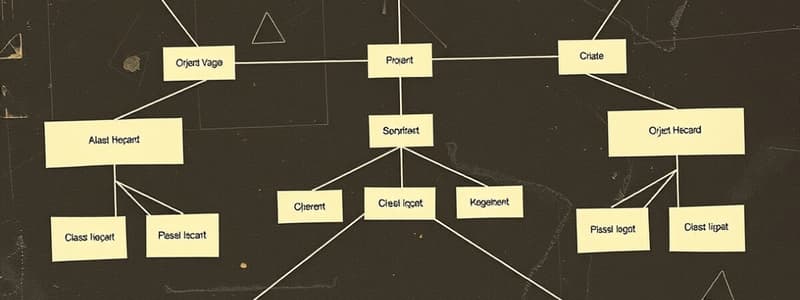Podcast
Questions and Answers
What shape represents an n-ary association in UML?
What shape represents an n-ary association in UML?
- Hollow diamond (correct)
- Solid triangle
- Hollow circle
- Solid square
Which best describes shared aggregation in UML?
Which best describes shared aggregation in UML?
- Parts exist independently of the whole. (correct)
- Parts are intrinsic to the whole.
- Parts can only belong to one whole.
- Parts are destroyed when the whole is destroyed.
What does a composition indicate in UML?
What does a composition indicate in UML?
- A part can only be contained in one composite object at a time. (correct)
- Parts have a weak dependency on the whole.
- A part can exist independently from the whole.
- Parts can belong to multiple wholes.
What is the purpose of a generalization relationship?
What is the purpose of a generalization relationship?
Which statement about subclasses in a generalization relationship is true?
Which statement about subclasses in a generalization relationship is true?
How is an association represented in UML?
How is an association represented in UML?
What distinguishes composition from shared aggregation?
What distinguishes composition from shared aggregation?
Which term describes the transfer of characteristics from a superclass to its subclasses?
Which term describes the transfer of characteristics from a superclass to its subclasses?
In UML, what does the term 'n-ary association' refer to?
In UML, what does the term 'n-ary association' refer to?
What is the role of a professor in the context described?
What is the role of a professor in the context described?
Flashcards are hidden until you start studying
Study Notes
Class and Object Diagrams
- Class diagrams model the static structure of a system, outlining elements and their relationships.
- Used throughout different software development phases, adapting detail level as the project progresses.
- Early phases focus on a conceptual view, facilitating vocabulary definition for the system.
- Object diagrams represent actual instances of objects at a particular time, reflecting data in classes.
Class Representation
- A class is depicted as a rectangle divided into compartments:
- First compartment: Class name.
- Second compartment: Class attributes (with types, e.g., integer, string).
- Third compartment: Operations (methods) of the class.
- Attributes may include a name, type, and optional default value (e.g.,
= Default). - Operations are executed when called; their signatures show operation name and parameters.
Access Control and Visibility
- Visibility defines access permissions for attributes and operations:
- Private: Accessible only by the object itself.
- Public: Accessible by any object.
- Protected: Accessible by the class and its subclasses.
- Package: Accessible by classes within the same package only.
- Information hiding is used to protect the internal state of objects.
Multiplicity in Relationships
- Describes how many instances of one class relate to instances of another:
- One-to-One: Each entity must have a corresponding single entity (e.g., students and ID cards).
- One-to-Many: A single entity can relate to multiple entities (e.g., students and courses).
- Many-to-Many: Multiple entities can relate to multiple entities (e.g., students and classes).
Associations and Relationships
- Binary associations connect instances of two classes, represented by solid lines.
- Relationships can be labeled for clarity, with navigability indicating access to partner objects' attributes.
- N-ary associations involve more than two classes, depicted with a hollow diamond at the center.
Aggregation and Composition
- Aggregation indicates that instances of one class are part of another; two types exist:
- Shared Aggregation: Parts exist independently of the whole.
- Composition: Parts are strictly bound to the whole object.
Generalization and Inheritance
- Generalization identifies common characteristics among classes, reducing redundancy.
- Inheritance allows subclasses to adopt attributes and behaviors of superclasses, establishing a hierarchical relationship.
- Each subclass is also an instance of its superclass, embodying shared characteristics.
Studying That Suits You
Use AI to generate personalized quizzes and flashcards to suit your learning preferences.




